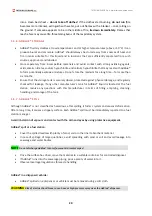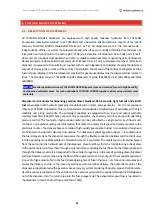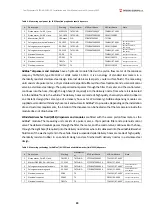
Fuel
Dispensers
TATSUNO
EUROPE
‐
Installation
and
User
Manual
,
revision
10,
January
2022
13
NOTE
‐
>ADB
AdBlue®
is
a
registered
trademark
of
VDA.
AdBlue®
is
also
known
as
AUS
32
(Aqueous
Urea
Solution)
or
DEF
(Diesel
Exhaust
Fluid).
NOTE
‐
>ADB
Legislation
and
a
technology
of
selective
catalytic
reduction.
All
vehicles
weighing
over
3.5
tons
belong
to
heavy
vehicles
and
new
European
regulations
for
heavy
vehicles
relate
to
them.
These
regulations
specify
maximum
values
of
PM
and
NOx
emissions.
For
the
vehicles
to
meet
new
European
regulations
of
EUTO
IV
and
EURO
V,
European
automotive
manufacturers
have
to
implement
new
technologies.
A
technology
of
selective
catalytic
reduction
(SCR)
includes
destruction
of
NOx
by
the
reaction
with
ammonia
when
harmless
water
and
nitrogen
are
produced.
The
solution
of
urea
required
by
the
SCR
system
is
called
AdBlue
®.
It
is
stored
in
a
tank
in
a
vehicle
and
injected
to
the
exhaust
system
where
the
reaction
occurs.
To
meet
the
Euro
IV
standards,
the
expected
consumption
of
AdBlue®
solution
is
about
5%
of
diesel
consumption
which
requires
a
tank
with
a
volume
between
50
to
100
litres.
A
consumption
of
6
‐
7%
is
expected
for
Euro
V.
1.3.4.
WINDSHIELD
WASHER
FLUID
CHARACTERISTICS
Windshield
washer
fluid
for
motor
vehicles
(hereinafter
referred
to
as
“WSE”)
is
a
solution
of
water,
detergents,
ethanol,
and
other
admixtures.
A
percentage
content
of
individual
components
in
the
agent
may
differ.
However,
a
maximum
content
of
ethanol
in
the
agent
is
limited
to
85%.
CAUTION
It
is
prohibited
to
use
a
dispenser
for
dispensing
an
agent
with
a
higher
content
of
ethanol
than
85%.!
1.3.5.
CNG
CHARACTERISTICS
CNG
is
a
business
name
for
C
ompressed
N
atural
G
as.
Natural
gas
is
formed
by
92–99
%
of
methane
and
the
rest
is
formed
by
inert
gases.
Table
2
‐
Physical
properties
of
CNG
and
their
comparison
to
other
fuels
CNG
Gasoline
Diesel
LPG
Octane
number,
range
128
91–98
‐
100
‐
110
Cetane
number,
range
‐
‐
51
‐
55
‐
Flash
temperature
[°C]
152
‐
20
55
‐
69
to
‐
60
Burning
temperature
[°C]
650
‐
20
80
‐
40
Ignition
temperature
[°C]
537
340
250
400
‐
450
Boiling
temperature
[°C]
‐
161.6
30
‐
210
180
‐
370
‐
42
to
‐
0.5
Density
at
15
°C
[kg/m
3
]
0.678
720
‐
775
800
‐
845
502
‐
579
Min.
heating
value
of
gaseous
phase
[MJ/m
3
]
or
liquid
phase
[MJ/kg]
34
43.5
41.8
46.5
94
Explosive
limit
in
air
mixture
[%]
4.4
to
15
0.6
to
8
0.6
to
6.5
1.5
to
9.5
Hazard
class
IV
I
III
I
The
table
means
the
following:
CNG
is,
compared
to
liquid
fuels
(petrol,
diesel,
LPG),
lighter
than
air.
The
flash
temperature
of
petrol
and
air
mixtures
is
significantly
lower
than
natural
gas
and
air
mixtures
which
increases
the
potential
of
the
risk
at
petrol
drives
compared
to
natural
gas
drives.
Natural
gas
has
the
most
favourable
explosive
limit
in
the
air
mixture
of
all
fuels.
In
terms
of
fire
safety,
CNG
is
less
risky
than
petrol
or
diesel.




























